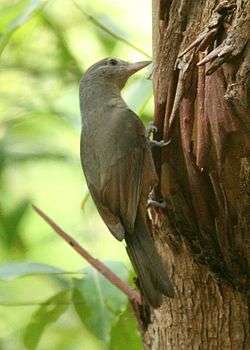Little shrikethrush
| Little shrikethrush | |
|---|---|
 | |
| Scientific classification | |
| Kingdom: | Animalia |
| Phylum: | Chordata |
| Class: | Aves |
| Order: | Passeriformes |
| Family: | Colluricinclidae |
| Genus: | Colluricincla |
| Species: | C. megarhyncha |
| Binomial name | |
| Colluricincla megarhyncha (Quoy & Gaimard, 1830) | |
The little shrikethrush (Colluricincla megarhyncha), also known as the rufous shrikethrush, is a species of bird in the Colluricinclidae family.
Taxonomy
Genetic investigations of New Guinea populations of the little shrikethrush indicate high levels of genetic divergence, suggesting it may comprise more than one species.[2] With at least eight separate clades identified as potential species splits, further research may lead to the re-classification of several new species.
Subspecies
Currently, twenty subspecies are recognized:[3]
- C. m. affinis - (Gray, GR, 1862): Found on Waigeo (off western New Guinea)
- C. m. batantae - (Meise, 1929): Found on Batanta (off western New Guinea)
- C. m. megarhyncha - (Quoy & Gaimard, 1830): Found on Salawati and Misool (off northwestern New Guinea), Aru Islands (off southwestern New Guinea) and New Guinea
- C. m. despecta - (Rothschild & Hartert, 1903): Found on southern coast of south-eastern New Guinea
- C. m. superflua - (Rothschild & Hartert, 1912): Found on northern coast of south-eastern New Guinea
- C. m. neos - (Mayr, 1931): Found in eastern New Guinea
- C. m. tappenbecki - Reichenow, 1898: Found in north-central New Guinea to Astrolabe Bay (north-eastern New Guinea)
- C. m. maeandrina - (Stresemann, 1921): Found in east-central New Guinea
- C. m. idenburgi - (Rand, 1940): Found in east-central New Guinea
- C. m. obscura - (Meyer, AB, 1874): Found on Yapen (off northwestern New Guinea)
- C. m. melanorhyncha - (Meyer, AB, 1874): Found on Biak (off northwestern New Guinea)
- C. m. fortis - (Gadow, 1883): Found on D'Entrecasteaux Archipelago and the Trobriand Islands (off southeastern New Guinea)
- C. m. discolor - De Vis, 1890: Found on Tagula Island (Louisiade Archipelago)
- C. m. parvula - Gould, 1845: Found in north-eastern Western Australia and northern Northern Territory (Australia)
- C. m. aelptes - Schodde & Mason, 1976: Found in north-eastern Northern Territory (Australia)
- C. m. normani - (Mathews, 1914): Found in northern Queensland and islands in the Torres Strait (Australia)
- C. m. griseata - (Gray, GR, 1858): Found in north-eastern Queensland (Australia)
- C. m. synaptica - Schodde & Mason, 1999: Found from southern Halifax Bay south to Sarina (north-eastern Australia)
- C. m. gouldii - (Gray, GR, 1858): Found from Broad Bay south to Hervey Bay (north-eastern Australia)
- C. m. rufogaster - Gould, 1845: Found south-eastern Queensland and north-eastern New South Wales (eastern Australia)
Distribution and Habitat
It is found in Australia, Indonesia, and Papua New Guinea. Its natural habitats are subtropical or tropical moist lowland forests and subtropical or tropical moist montane forests.[1]
Ecology
During a study of the toxicity of the genus Pitohui, two specimens of this species have been tested. One of the two specimens did have traces of batrachotoxins (BTXs) similar to those found in the secretions of Central and South American poison dart frogs.[4]
References
- 1 2 BirdLife International (2013). "Colluricincla megarhyncha". IUCN Red List of Threatened Species. Version 2013.2. International Union for Conservation of Nature. Retrieved 26 November 2013.
- ↑ Deiner, Kristy; Lemmon, Alan R.; Mack, Andrew L.; Fleischer, Robert C.; Dumbacher, John P. (2011). "A Passerine Bird's Evolution Corroborates the Geologic History of the Island of New Guinea". PLoS. 6 (5): e19479. doi:10.1371/journal.pone.0019479.
- ↑ "IOC World Bird List 6.3". IOC World Bird List Datasets. doi:10.14344/ioc.ml.6.3.
- ↑ Avian chemical defense: Toxic birds not of a feather
